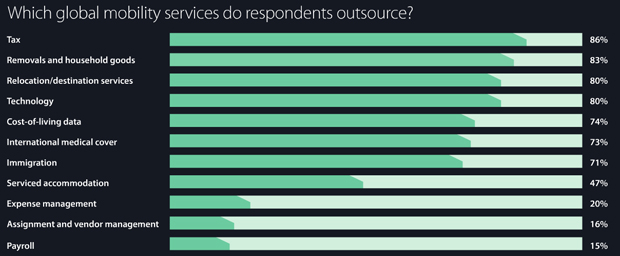As emerging markets grow and employers send more staff overseas, it is important for global mobility managers to develop cost-effective programmes to help expatriates move around the globe.

If you read nothing else, read this …
- A multinational employer requires a centralised policy or set of guidelines to underpin its global mobility programme .
- Employers must consider how they will pay expatriate staff and which benefits they will use to support them.
- Employers should assess the value of outsourcing tax and legal services to third-party specialists.
However, 78% of the senior global mobility professionals who responded to research conducted by EY in October 2013 said their organisation’s global mobility function did not measure return on investment.
Stephanie Phizackerley, partner in EY’s UK and Ireland global mobility practice, says: “To demonstrate a return on investment, the employer has to work out what is most important, including whether it is cost-effective to send employees on assignment.”
Phizackerley says employers can measure absolute cost by assessing an employee’s success in delivering specific business objectives, or by looking at how well they perform when they return.
But organisations’ mobility functions can get bogged down in process activity because a global programme touches on such diverse areas as reward, talent, finance and tax. Global employers with HR teams in a variety of countries often require different HR systems and payroll providers, which can complicate matters further.
Smaller employers, in particular, are likely to become overwhelmed by mobility processes.
Robert Hodkinson, partner in Deloitte’s global employer services team, says: “Larger organisations will have procedures in place, but employers that are becoming more global will struggle to map all these issues out, because HR is often a function that is domestically focused.”
However, organisations, big and small, need to grasp what mobility management involves, because [mobility managers] need to get more heavily involved in workforce planning strategy.
“Mobility, which has historically been an operational function, is now being asked to really get engaged in broader workforce planning conversations and being more at the front of it, rather than making it happen after decisions have been made,” says Hodkinson. “[Mobility is] now being asked to engage at the planning and strategic end of it.
“That is creating a challenge, because a lot of mobility practices and teams aren’t geared up to do that, which is why there is a big need and appetite for re-engineering the mobility function within organisations.”
Centralised policies
As with any project undertaken by HR, a global mobility programme should begin with a centralised policy, but its shape will depend on the size of the organisation and the number of expatriates being sent on assignment.
Jacqueline O’Rourke, head of client services and account management at expatriate service provider ECA International, says: “It’s fine if an employer has just one or two expatriates; then it can be pretty flexible. But most organisations tend to have five or 10 expatriates, and then they have to have some sort of structure in place.”
Some elements of an employer’s policy will be outsourced and some will be managed in-house, and this also depends on the size of the expatriate population. Tom Richards, director and head of the London expatriate tax team at accountancy firm Grant Thornton, says: “The larger the population an organisation is moving, the more likely it will have to develop internal expertise and do calculations in-house.”
Pay policy
Employers should next decide how they will pay their expatriate staff, because pay standards and the cost of living, plus tax rates, will vary across the globe.
“Are employers going to base it around the local market, or adopt an expatriate balance sheet approach, which is a way of trying to replicate their buying power in their home country?” says Richards.
Benefits to support expatriate employees must then be considered. Alongside the typical employee benefits, employers might include relocation costs, accommodation, school fees, travel, home leave or culture and language courses.
Managing the global mobility function 2013 , published by the Forum for Expatriate Management (FEM) in September 2013, provides detailed analysis of the costs of outsourcing these services. For example, among employers with between 100 and 1,000 expatriate staff, the average cost of relocation services was US$4,019 (£2,452) per assignee, while removals and household goods cost an average of US$6,256 (£3,818) per assignee.
Some countries offer tax incentives for these types of service. Helen Boggis, manager of tax services at ECA International, says: “Depending on the rules of particular countries, employers can provide benefits in a more tax-efficient way . In some cases, it might be better to provide the benefit directly from the employer rather than providing a cash allowance. Certain mobility benefits, such as relocation expenses, could be provided tax-free.”
For example, in Hong Kong, housing allowances paid in cash are fully taxable, while in the UK, the first £8,000 of relocation costs is tax-free.
But David Heaton, tax partner in Baker Tilly’s employer solutions team, warns: “When [employers] take into account the costs of moving [an employee], such as legal fees, agent fees, travel costs and shipping fees, they soon use up their £8,000 allowance. There will be some taxable benefits in there, which need to be grossed up.”
Outsourcing to a specialist
When deciding which benefits to offer overseas assignees, employers must consider the country to which employees are moving and the local tax rules. They may have to outsource this task to a specialist, both to provide the benefit and to ensure cost efficiency.
Grant Thornton’s Richards says: “An employer can then benefit from that specialist’s buying power and experience in the market. That organisation would do all the administration around preparing the letters, doing the calculations and then it would go out to various suppliers and specialist services, such as shipping and relocation, destination services, visa and immigration services, and tax advisory services.
“It is becoming more popular, particularly for smaller organisations, to use providers where they basically have a one-stop shop to buy all these services.”
Legal and tax services
A particularly important consideration is the legal and tax services an employer uses, because non-compliance can result in a fine. “The compliance environment around staff moving across borders is becoming more strict in certain jurisdictions,” says Richards.
He points out that a Freedom of Information request revealed that the UK government earned £120 million from compliance checks on international employees in the last year alone, which was generated from the individuals’ employers.
Regulatory requirements around visas, social security and tax rates are increasingly important, which is why Deloitte’s Hodkinson believes employers should use tax specialists to support their mobility programmes.
“Tax is one of those things employers can never really expect an in-house function to do,” he says. ”The bigger programmes try to have a tax person imbedded in the team, so they can have [an employee] who talks the language of tax and can interact between the professional providers in two different jurisdictions, and act as a conduit to the HR community.”
Either way, when an employer is moving staff to an overseas jurisdiction, or bringing them into the UK, it must work out where they are taxable, what forms need to be filed and when. It needs to understand the market the employee is coming from and going into, because the requirements will be different.
Big costs
Employers must also understand the biggest costs they will face when creating a global mobility policy. These range from pay packages and accompanying benefits through to tax and legal compliance , but although this expenditure adds up, it is still possible to be cost-efficient.
Hodkinson says: “Employers have to pay staff, so that’s not a real cost, and the vendor costs aren’t very high. The big costs are the allowances and what is provided to incentivise staff to go.
“Employers should take a bit more rigour around who is benefiting from the move, the business or the assignee, and then focus on spending the money on employees who will be the most benefit to the organisation.”
The ECA’s O’Rourke adds: “There are different types of package, but employers have to decide what they want within their policy. If an employer wants global mobility in its organisation, sometimes it does cost money to get staff around the world.”

Source: Managing the global mobility function 2013 , published by the Forum for Expatriate Management in September 2013
Case study: Lloyd’s Register to centralise global mobility service

Lloyd’s Register is developing a centralised global mobility service for its international locations. The organisation has about 200 formal expatriate employees.
Selina Jones-May, head of global mobility at Lloyd’s Register, started the process in April 2013 and has been process-mapping all of the global mobility function.
An integral part of the process was to obtain approval from the organisation’s executive committee by submitting a robust business case, which included models of the project’s financials and return on investment.
“I engaged with all key internal stakeholders, such as finance and procurement, and external vendors, to estimate the current total cost of the global mobility programme and the projected cost savings that could be achieved through centralisation,” says Jones-May.
She recommends that all employers benchmark their current, and any proposed, operating models against those of other organisations and the overall market.
“When I started my due diligence, I used a number of well-reputed surveys on the structure and headcounts associated with a centralised global mobility function with our assignee population size,” she says.
“This provided me with a benchmark in terms of the final target ratio of full-time headcount to assignee population. The importance of incorporating independently benchmarked data on hundreds of peer-group organisations within the final business case is inestimable.”
Myrianthe Ewington: Global mobility professionals have a lot to think about

Despite the recent tough global economy, more and more organisations are moving their top talent around the globe in pursuit of new business or expansion in existing locations.
As any global mobility professional knows, there is a higher workload when it comes to assignees, and also a greater risk. There are many aspects to consider, such as tax, immigration, removals and health insurance; no one person can be an expert in all fields. And with governments tightening up on compliance, it is more important than ever for organisations to track and monitor their assignees to ensure consistency and compliance.
Potential issue
Global mobility professionals need to be aware when there is a potential issue and when specific providers need to be directly involved. But not all issues require an expert and, to minimise costs, it is important to know when to use in-house knowledge or, perhaps, experience gained from a previous assignee. It’s all about getting the balance right.
A useful point of call is an employer’s industry network. Some of their industry peers may already have gone through a successful, or painful, provider selection process, and may have some top tips on what to ask and what to avoid.
Great insight
Any feedback should be taken on its own merit, allowing for bad experiences, which may taint an opinion, but on the whole this can provide a great insight into how the process should go and which the top providers are in the market.
When it comes to the formal request for proposals, it is really important for employers to obtain stakeholder engagement and to develop objective scorecards that clearly demonstrate the benefits each service provider offers, including potential cost savings. This will help sift through the sales pitches and will also help providers to tailor their proposals more effectively for an organisation.
Myrianthe Ewington is chapter and member services manager at the Forum for Expatriate Management
elastic braids is the most multipurpose offered. It can be ideal for waistbands, sleeves, necklines, legbands plus more. It is actually shrink resistant and unaffected by chlorine and salt h2o.